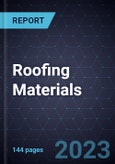Investment in Technology Advancements and Increasing Activity in Residential and Commercial Building Reconstruction to Boost Market Potential
The global roofing materials market will reach $165.57 billion by 2030. Increasing investments in residential and commercial building reconstruction will drive market growth. Metal, asphalt, plastic/membrane, and other materials (including clay tiles, solar technology, and green roofs) are the four main product types in the roofing materials market study. Different end-use applications for each product type are discussed, as well as the key products and technologies. Applications are quantitatively explained for the four main product types regarding the total roofing materials market. The global market is presented as 5 key regions, each covered both quantitatively and qualitatively.
Established long-term relationships between customers and manufacturers and high brand loyalty are characteristics of the roofing industry. Major market players focus on offering a wide range of products and better quality than competitors to enhance brand reputation. Major companies are adopting robust market positioning strategies focused on integrated roofing system services by combining product portfolios with other roofing components to achieve a competitive advantage over local manufacturers and suppliers. The market is highly fragmented, with several big players and a large variety of small companies focusing on a specific product and region.
Product price is based on square footage. The pricing calculation considers supply chain disruptions, average material pricing, and the typical product amount/overlap/waste on the jobsite. Revenue calculations and unit shipment forecasting use the average material pricing by correlating material volume to a distinct monetary value.
Asia-Pacific (APAC) will drive market demand. Factors including rapid urbanization, population expansion, and increasing per capita income have a driven rapid increase in demand from emerging markets, such as Vietnam, Indonesia, and India. The Middle East and North Africa (MENA) will see the highest market growth. This region is experiencing robust expansion in construction and industrial applications, allowing initial growth emersion as these segments develop. The Middle East is heavily industrializing, increasing commercial and industrial structure demand.
Metal roofs, with high initial and low long-term costs, will emerge as the fastest-growing product segment because of their long service life and durability. The other materials category, which includes various materials such as clay, cement, wood, tiles, green roofs, and solar, is the largest market size; however, asphalt is the single-segmented product group that will dominate the market size-wise.
Compared to commercial, residential will be the largest and second-fastest-growing segment because of developing markets with high population growth and a greater demand for more/larger houses and residential roofing. Reroofing will drive the residential market as consumers replace products at the end of life, fix damage, or switch product types, increasing product demand. The industrial segment will see decent growth because of the development of many industries in less-developed markets.








